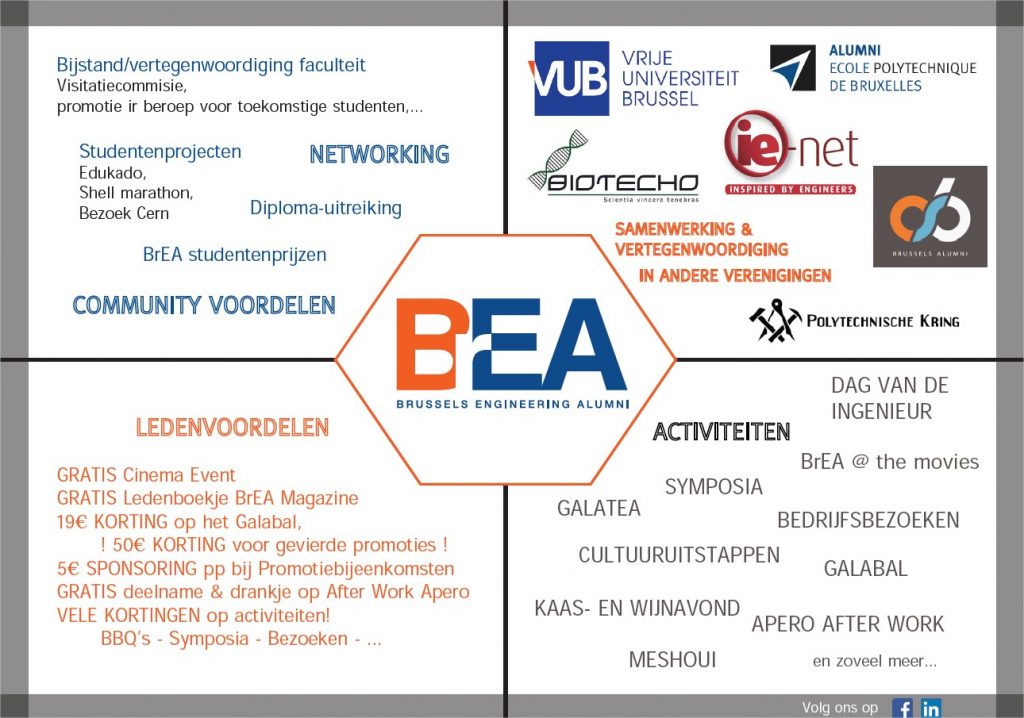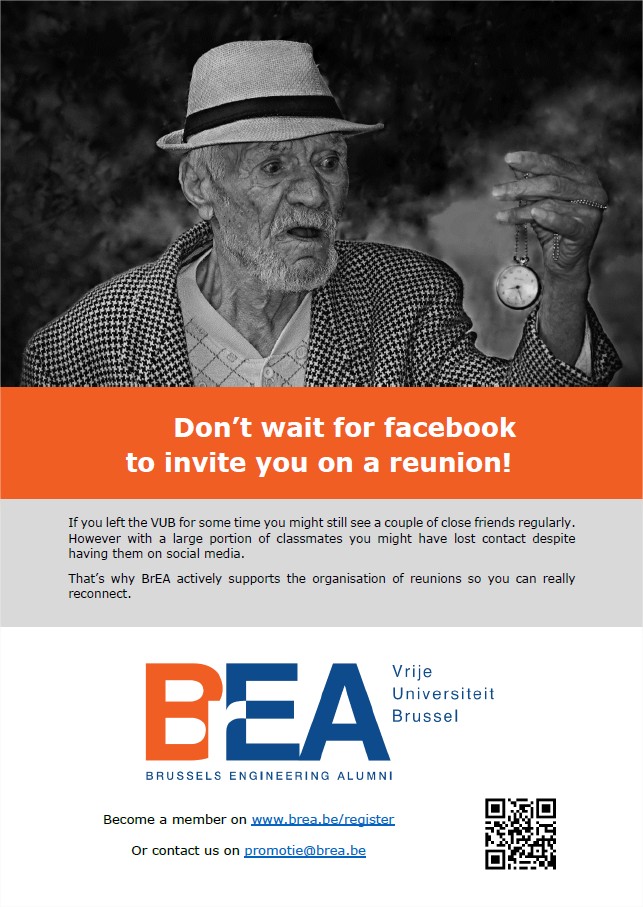Four steps to pitch your project
What is the best way to pitch your research or project? We already covered this in a previous post, but let’s now look at a very hands-on application, where we redesign a project flyer by BrEA in four steps.
The techniques we use can equally be used to pitch a project to an investor, when your friends ask you ‘what exactly it is you do’, or when you are asked to share your future research plans to your research group.
Flyer before and after
BrEA is the alumni association of engineers at the University of Brussels (VUB). Their aim is to bring together engineers and involve them in their association’s activities, but felt that their communication was not always hitting the mark. Together we looked at how Brea could best pitch its ideas to its target audience.
This is the BREA flyer before and after the redesign (which they completed independently following the workshop). We hope you will agree that the redesigned version is much clearer and more appealing. But what is the secret?
BEFORE

AFTER

What exactly did we do?
For this redesigned version we did some cutting and pasting, where we joined different elements to create a clear and appealing message.
Question 1: Who is your target audience?
Brea has several target audiences that are similar in some ways, but do have very diverse interests. Such as:
- the engineer, graduating this year, whom Brea would like to involve in their activities.
- the engineer, who has been working for the past one or two years and is looking to join a network.
- the engineer, who has been working several dozens of years, and is looking for a sounding board among fellow engineers.
Designing a single flyer/pitch/poster to reach different target audiences is challenging. Each target audience has a unique set of expectations and problems. Focus on one single target audience at a time. This will not only simplify your work but will also make your message stand out. Because Brea mainly wants to attract new members, we chose to focus on the students graduating this year.
Tip: Want to pitch a project or idea? Always ask yourself: who is your pitch aimed at? By focusing on a specific target audience, you’ll have no problem composing a message that will hit the mark.
Question 2: What is your main message? What Is the call for action?
For Brea this is very straightforward: they would like to see graduating engineers join their association. This was not mentioned on the old flyer but did make it onto the new one. If you want people to specifically do something after hearing a pitch or reading a flyer, be sure to tell them.
Tip: Want to pitch a project or idea? Always state your main message loud and clear during your presentation or -in this case- on your flyer. Don’t just assume that your audience will derive that main message on their own. By stating it yourself, you have a better chance of them picking up on it.
Question 3: What problem is your target audience struggling with and how will you solve it?
What problem are the students that BREA wants to attract struggling with? According to the old flyer that would be a lack of activities. This seems to be the most important element included on the old flyer.
But ‘a lack of activities’ is not really a problem or direct reason for this target audience to sign up: most students have a pretty good social life. After some deeper digging at the workshop, the true issue was uncovered: after graduating, students do stay in touch with their best friends, but not with the other fun people they had had a more casual contact with in the group. Those fun acquaintances could easily form an interesting and useful network. The solution: Brea hosts activities to also keep you in touch with those people.
Tip: Want to pitch a project or idea? Always mention the problem your target audience is struggling with. And especially how you intend to solve this for them. Once people realize what the problem is, they will be more open to hear how you can help them solve it. Sometimes pinpointing the problem will take some digging.
Question 4: What advantage will your target audience get out of it?
As for Brea, becoming a member will definitely help you out professionally: Brea provides you with an extensive, fairly accessible network. This was not mentioned on the old flyer but did make it onto the new one.
Tip: Want to pitch a project or idea? Always state what it is you have to offer to your target audience. The advantage may be very straightforward, but it will still be worth mentioning. Perhaps it just isn’t very clear? Then definitely say it. Don’t just assume that your audience will be able to deduce what they have to gain from you solving their problem.
Now that you have the content of your pitch, you will still need to design the complete picture. That is something for a future blog post, but we hope that you will see that Brea’s new and improved flyer is much more appealing than the previous one. Because it is so much more attractive, people will be more inclined to read it.
And when they do finally read it, your well-designed content is sure to put you one giant leap ahead!